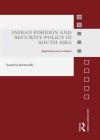Indian Foreign and Security Policy in South Asia: Regional Power Strategies
Written by: Sandra Destradi,
Routledge, 2012,
ISBN 9780415721240, 200pp
Reviewed by: Ash Khan
India is mentioned in foreign policy circles almost exclusively in three contexts: as an emerging great power, as Pakistan’s perennial enemy, and as China’s long-term challenger. This makes Sandra Destradi’s book, Indian Foreign and Security Policy in South Asia: Regional Power Strategies, a rare book that seeks to illuminate India’s troubles closer to home and, for all the talk of India’s growing power, describe how New Delhi has struggled to assert itself with its much smaller neighbours. The result, however, is a book that is burdened by its past life as a PhD thesis and ultimately this limits the degree of analysis of India’s South Asia policy and its value for the general reader.
Destradi invests heavily in her theoretical framework in order to mount her argument. The result is a heady serving of critical theory; those readers interested in Indian foreign policy and South Asian security rather than international relations theory are advised to skip immediately to page 57. For others interested in constructivist approaches to empire, hegemony and leadership, Destradi offers a useful academic review of the terms in a long first chapter that delineates hegemony from the more benign role of leadership and a more coercive imperial approach. Too often, these theoretical discussions are drawn out beyond a useful point, such as Destradi’s dedicating several pages to defining broadly accepted terms such as ‘region’ or ‘South Asia’.
Destradi’s focus on India starts with Chapter 3, where she extrapolates an outline of India’s foreign policy from public statements made by the Ministry of External Affairs and interviews she held on the ground. In this chapter, a rather paltry seven pages compared to the 40 spent on theoretical discussions, Destradi presents the enormous scale of India’s preponderance in South Asia and New Delhi’s five regional goals: stability, security, economic growth, democracy and preserving its regional influence in the face of competition from China and Pakistan. Destradi is careful to note that, ‘[w]hile economic interdependence might be helpful, security issues clearly remain in the forefront’.
In the chapters that follow on Sri Lanka, Nepal and Bangladesh, Destradi offers a broad history of India’s relations with these countries to demonstrate the successes and failures of India’s purported hegemonic strategy. These chapters provide brief and useful, but often clumsy introductions to the history of relations between India and its smaller neighbours. Destradi sweeps through India’s disastrous military involvement in Sri Lanka’s civil war to the painful democratisation that led to a Maoist government in Nepal and New Delhi’s frustration with the emerging security threats from and poor relations with Bangladesh. Destradi seeks to demonstrate a linear connection between India’s ‘hegemonic strategies’ with these countries and its successes and failures. However, in offering this broad sweep of history, Destradi rarely presents a cogent analysis of the drivers of the relationships.
Critically, Destradi fails to place India’s South Asia policies within the framework of its grand strategy which is heavily skewed towards Pakistan, China, non- alignment and its great power ambitions. Moreover, there is a distinct failure to mention, let alone explore, shortcomings within India’s foreign policy, such as poor planning, lack of a regional vision, insularity and influence of vested ethno-religious interests, which have resulted in some of New Delhi’s failures in Sri Lanka, Nepal and Bangladesh. But Destradi’s greatest flaw is that she fails to explore the deeper ethnic and religious drivers of India’s relationship with these three countries. Without examining these issues, even Destradi’s narrowly focused central thesis of demonstrating India’s hegemonic foreign policy cannot be fully assessed or explained. The result is a book that, while it demonstrates that India has largely failed to translate its overwhelming power into influence as a hegemon in South Asia, makes a limited contribution to a thin body of literature on India’s South Asian policies that is in dire need of some meat.

